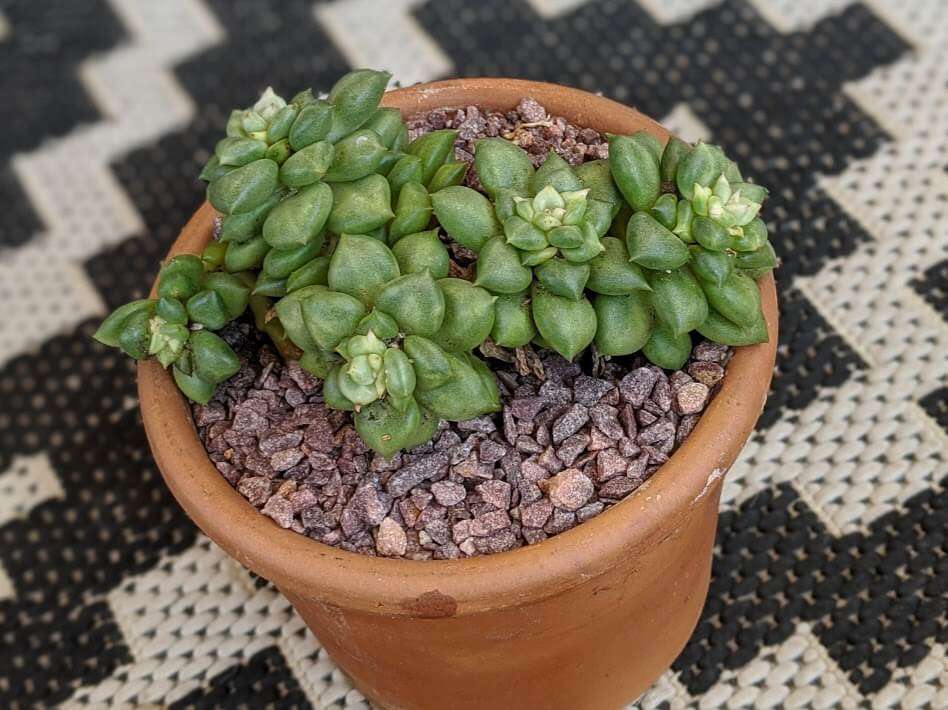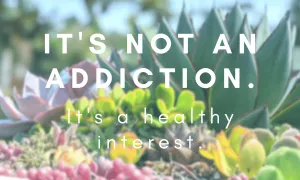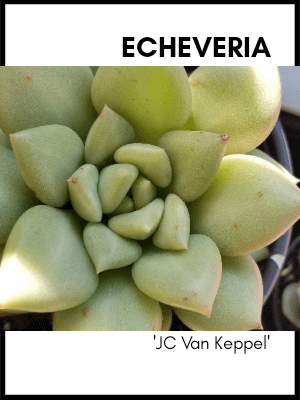Echeveria ‘JC Van Keppel’ is a popular hybrid succulent that is highly valued for its attractive appearance and ease of care. Here’s everything you need to know about this beautiful succulent.

Description
Echeveria ‘JC Van Keppel’ is a stunning rosette-shaped succulent with thick, pointed leaves that are green with reddish-pink margins. The plant can grow up to 12 inches (30 cm) wide and 6 inches (15 cm) tall. It produces lovely coral-colored blooms on tall, thin stalks that appear in late winter or early spring.
Echeveria ‘JC Van Keppel’ is a hybrid succulent that was developed by John Trager, the curator of the Huntington Botanical Gardens. As a hybrid, it does not have a natural habitat in the wild. Instead, it is a cultivated plant that has become popular among succulent collectors and growers worldwide.
How to Water
Echeveria ‘JC Van Keppel’ requires well-draining soil and should be watered thoroughly but only when the soil is completely dry. Water the plant deeply but infrequently, allowing the soil to dry out completely between watering sessions. Overwatering can lead to root rot and other problems.
What are the signs of overwatering?
Some common signs of overwatering include:
• Wilting. The leaves may wilt or droop, even though the soil is moist. This happens because the roots cannot uptake the water and oxygen effectively when they are waterlogged.
• Leaf drop. Excessive moisture can lead to leaf drop, especially of lower leaves. As overwatering persists, more leaves may drop until only a few remain.
• Mold or mildew. Excess moisture on leaves and soil can lead to the growth of mold, mildew, or fungal disease. You may notice a white or grey powdery substance on the leaves or in the pot.
• Slow growth. With too much moisture, the roots cannot function properly to uptake nutrients and water for the plant. This leads to stunted or slowed growth and an unhealthy appearance.
• Soft stem or leaves. The stem or leaves may turn soft, translucent, or mushy due to too much moisture. In severe cases of overwatering, the entire stem and leaves may rot and decay.
• Root rot. When roots sit in water for too long, they can rot and turn brown or black. Overwatering is the most common cause of root rot. If root rot is detected, the damaged roots will need to be pruned and the plant repotted in fresh, dry soil.
• Pests or disease. Excess moisture creates an ideal environment for pests and disease to thrive. Fungi, bacteria, and other pathogens spread more easily in wet soil and on damp leaves. Managing water properly will help avoid related pest and disease problems.
If you notice signs of overwatering, scale back how often you water your plant. Allow the soil to dry out before the next watering and consider repotting in fresh, well-draining soil if root rot is present. With time and adjusted care, many plants can recover from overwatering by providing a dryer environment.
Soil
Echeveria ‘JC Van Keppel’ prefers well-draining soil that is made up of 50% mineral grit and 50% organic matter. The ideal soil mix for this succulent should contain Turface, pumice, perlite, and coarse sand. These amendments help improve soil drainage, prevent soil compaction, and ensure the plant receives the necessary nutrients.
How to Propagate
Echeveria ‘JC Van Keppel’ can be propagated easily through stem cuttings or leaf cuttings. To propagate through stem cuttings, take a stem cutting and allow it to callus for a day or two before planting it in well-draining soil. To propagate through leaf cuttings, gently remove a healthy leaf from the plant and allow it to callus over for a day or two. Then plant the leaf in a well-draining soil mix, keeping it slightly moist until it develops new roots and a rosette of leaves.
Light
Echeveria ‘JC Van Keppel’ requires bright, indirect sunlight for at least six hours each day. Direct sunlight can scorch the leaves of this succulent, so it’s best to place it near a sunny window but out of direct sunlight. If you’re growing Echeveria ‘JC Van Keppel’ outdoors, it should be protected from hot afternoon sun.
Echeveria JC Van Keppel is a hybrid succulent plant that requires bright, indirect light to thrive. Ideally, it should be placed in a location where it can receive at least 6 hours of bright, indirect sunlight per day.
However, direct sunlight can be too intense for this plant and can cause its leaves to scorch or sunburn. Therefore, it is recommended to provide some shade during the hottest part of the day, especially during summer months or in areas with intense sunlight.
If you are growing Echeveria JC Van Keppel indoors, place it near a south-facing window or under artificial grow lights to ensure it receives adequate light. Make sure to rotate the plant regularly to ensure all sides receive equal light exposure.
Overall, Echeveria JC Van Keppel is a relatively easy plant to care for, as long as it is provided with the right amount of light and water.
Can Echeveria JC Van Keppel survive in low light conditions?
Echeveria JC Van Keppel is a succulent plant that requires bright, indirect light to thrive, and it may not survive in low light conditions. If it is grown in low light conditions, the plant may become leggy as it stretches towards the light source, and its leaves may lose their vibrant color and become dull.
If you want to grow Echeveria JC Van Keppel in low light conditions, you can supplement the natural light with artificial grow lights. Choose a high-quality grow light that emits a full spectrum of light, including blue and red wavelengths, which are essential for plant growth. Position the grow light about 6 to 12 inches above the plant and keep it on for 12 to 16 hours per day.
However, keep in mind that even with artificial grow lights, Echeveria JC Van Keppel may not thrive as well as it would in bright, indirect sunlight. If possible, it is recommended to provide the plant with as much natural light as possible to ensure its optimal growth and health.
What are some signs that my Echeveria JC Van Keppel is not getting enough light?
If your Echeveria JC Van Keppel is not getting enough light, there are several signs you may notice:
Leggy growth: If the plant is not getting enough light, it may stretch out and become leggy as it tries to reach for the light. This can cause the plant to become top-heavy and unstable.
Fading colors: Echeveria JC Van Keppel has vibrant, colorful leaves, but if it is not getting enough light, the colors may fade or become dull.
Stunted growth: Without enough light, the plant may grow slowly or not at all. The leaves may also be smaller than normal.
Leaf drop: If the plant is not getting enough light, it may drop leaves, especially from the lower part of the plant.
No flowers: Echeveria JC Van Keppel can produce beautiful flowers, but if it is not getting enough light, it may not bloom at all.
If you notice any of these signs, it’s a good idea to move your Echeveria JC Van Keppel to a location with more light. However, be sure to do this gradually, as sudden changes in light exposure can shock the plant and cause it to drop leaves or become damaged.
What are some common mistakes to avoid when moving my Echeveria JC Van Keppel to a location with more light?
When moving your Echeveria JC Van Keppel to a location with more light, there are some common mistakes you should avoid to prevent damaging the plant:
Sudden exposure to direct sunlight: If you move the plant to a location with direct sunlight, the sudden exposure can cause the leaves to scorch or sunburn. It’s best to gradually acclimate the plant to more sunlight by placing it in a location with filtered light for a few days before moving it to a location with more direct sunlight.
Overwatering: With more light, the plant will likely require more water, but it’s important not to overwater it. Make sure the soil is completely dry before watering and be careful not to water the leaves or the center of the rosette, as this can cause the plant to rot.
Lack of humidity: If you move the plant to a location with more light, the air may be drier, which can cause the leaves to dry out and become crispy. To prevent this, you can increase the humidity around the plant by placing a tray of water nearby or misting the leaves regularly.
Lack of drainage: If the plant is in a container without drainage holes, it may become waterlogged and suffer from root rot. Make sure the container has drainage holes to allow excess water to escape.
Too much fertilizer: With more light, the plant may require more nutrients, but it’s important not to over-fertilize. Too much fertilizer can burn the roots and cause the plant to become stressed.
By avoiding these common mistakes and gradually acclimating the plant to more light, you can help your Echeveria JC Van Keppel thrive and grow healthy.
Fertilizer
Echeveria ‘JC Van Keppel’ requires very little fertilizer, as too much can harm the plant. Feed it once a month during the growing season with a balanced, water-soluble fertilizer diluted to half strength.
Common Problems & Solutions
Echeveria ‘JC Van Keppel’ is generally a hardy plant, but it can be susceptible to common succulent problems such as mealybugs and aphids. If you notice any signs of infestation, isolate the plant immediately and treat it with an insecticidal soap or neem oil. Overwatering can also cause root rot and other problems, so make sure to water the plant only when the soil is completely dry.
Hardiness Zone & Temperature
Echeveria ‘JC Van Keppel’ is a tender succulent that is hardy in USDA zones 9b to 11b. It prefers warm temperatures between 60°F to 80°F (15°C to 27°C) and can’t tolerate temperatures below 32°F (0°C).



